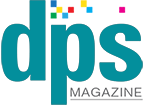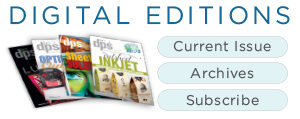
by Cassandra Balentine
Digital print and supporting technologies meet evolving demands for a growing list of scenarios and applications. “In settings where on demand, short run, or variable printing is required, digital printing can enable quick turnaround and lower changeover costs,” confirms John Butler, senior director, North America Sales, Teledyne DALSA.
Above: Output examples from HP PageWide inkjet presses.
Dario Urbinati, CEO, Gallus Group, is excited to see the continued rise of digital printing technologies and innovation. “As the digital landscape grows and evolves, the benefits of digital—such as more profitable short runs, personalization, and on demand printing—will become more accessible.”
Simon Lewis, SVP marketing, strategy and business development, Highcon, attests that digital maturity means companies are focused on digital impact.“This means software, automation, integration, a holistic approach, an end-to-end view, and lots of hard work.”
While investing in a piece of digital print equipment may be “easy” compared to reinventing workflows and production flows, Lewis stresses that it typically requires expertise that may not be present in the organization. “It requires lots of people to change what and how they do things and different kinds of collaboration.”
Inkjet Matures
Advancements in inkjet and other digital print technologies continue to dominate the short-run market with fast turnaround times, flexibility, and color accuracy, confirms Marc Raad, president, Significans Automation.
“Now more than ever, inkjet has become a survival tool. It’s ink but on a digital platform that anyone can use,” shares Jesse Heindl, marketing manager, RISO.
Dustin Graupman, senior direct, inkjet division, Kyocera Document Solutions America, Inc., agrees, noting that entry-level cutsheet inkjet technology is on the verge of becoming competitive with toner, particularly in producing high-quality results on gloss-coated media.
Inkjet is also making waves in higher production segments. Lance Martin, VP product marketing, Komori America, says sheetfed inkjet options made a “quantum leap in productivity. The proliferation of higher speed B2-plus size inkjet presses is remarkable.”
Earlier this year, Komori announced the J-throne 29 UV Inkjet, B2-plus size press for this market with production speeds of 6,000 sheets per hour, which Martin says doubles previous offerings. “This new technology fits well with existing offset—Komori’s other core technology—processes for commercial print. We believe the model of the commercial printer for the near future will be a hybrid of offset and inkjet printing, and a myriad of finishing options, all under the same roof,” he attests.
The increase of B2-format solutions are designed to facilitate the transition from offset to digital printing. “However, this range of options has, for some customers, resulted in ‘paralysis by analysis,’ as they struggle to choose between too many alternatives,” admits Graupman.
Inkjet and other digital print technologies is also influencing label and package production.
Steve Lynn, director of labels and packaging, Durst North America, believes that 1,200 dpi inkjet took a strong foothold in the label industry over the past year. “This technology has been around for a few years but this year we saw acceptance that it is a stable technology that can replace flexography and slower, inefficient toner technology.”
The packaging print sector is experiencing growth driven by ecommerce and the consumer’s need for innovative and interactive packaging solutions that also serve as marketing tools, comments Raad. “On demand printing services are also expanding, especially opportunities for customized and personalized print.”
“Inkjet is quickly becoming a more cost effective and sustainable way to produce customized, short-run packaging and label jobs. One of the most exciting launches at drupa was the X5 Nozomi from EFI and Packsize. It’s the first full-color, on-demand, right-sized box system that transforms blank corrugated into personalized, on-demand boxes in seconds,” offers John Henze, VP, marketing and sales, Fiery.
The adoption of advanced variable data printing and code verification capabilities is supported by the global transition from retail barcodes to quick response (QR) codes. “Packaging converters add monochrome printers to their analog packaging lines to support the transition, with code inspection and verification technology often deployed to provide reassurance that all individual codes generated and printed are valid,” shares Michael Matthews, product manager – DP Colour, Domino Printing Sciences.
The biggest advancements in coding and marking are regulatory products necessary for brands to adhere to new, stricter barcode standards. Printing systems are now capable of producing ultra-fine details—barcodes, QR codes, batch numbers—at high speeds without compromising quality. “The new printheads and ink delivery mechanisms reduce smudging, misprints, or fading, especially important in industries like pharmaceuticals and food and beverage, where readability is crucial,” explains Pat Harnett, director of portfolio and development, HP Specialty Printing and Technology Solutions.
Vision inspection and monitoring are also popular for color label printing applications where consistent, reliable quality can be a key selling point, providing peace of mind for brands and securing those all-important repeat orders, adds Matthews.
Finally, “inkjet, wide format, and textile printing continues to evolve and impress, enabling unique, customized print products,” says Raad.
Rise of AI
Artificial intelligence (AI) has officially entered the discussion, but it hasn’t yet taken hold.
Piet De Pauw, head of marketing, Enfocus, says 2024 was the year AI really started to take center stage in the industry, “but we’re still only scratching the surface of its potential applications in printing.”
Lewis comments that AI can be part of the road to digitalization now, but it doesn’t necessarily have to be. “The AI revolution is yet to arrive. And for many businesses, this frightening and threatening reinvention of how to work to enjoy the digital dividend is sufficiently challenging without getting into the cutting edge of AI. None of this obviates the need or business case of investing in new equipment. Digital die cutting, for example, is the only way to deliver a never-seen-before carton job within a day or two of receipt. But when the company’s automation infrastructure and workflow capabilities support this kind of performance, it makes it much easier to really deliver the impact for customers and the converter,” he suggests.
Print providers and buyers will be able to leverage AI technology for better targeting, messaging, automated workflows, and optimized print production, etc., predicts Tonya Powers, senior director of marketing, Client Services Group, Canon U.S.A., Inc.
Naimish Patel, VP of sales, OnPrintShop, points out that AI plays a pivotal role in web to print, especially in terms of image and content creation. “Print shops can leverage AI to generate product mock ups or design images based on templates, making it easier to personalize designs without additional resources.”
The rise of AI is relevant to the production domain, where workflow and printing processes saw the introduction of advanced AI tools to improve yield and ensure perfect output, shares Nir Zarmi, SVP, growth and strategy, Landa.
Moreover, the use of generative AI in text, messaging, and image creation is extensive. “This holds the promise of a boost to highly agile, variable data printing at levels unknown previously,” comments Zarmi.
“AI integration is increasingly embedded into printing processes, optimizing workflows, enhancing predictive maintenance, and improving overall efficiency,” notes Mary Gay Pettit, public relations, Markzware, Inc.
Ernie Crawford, M-EDP, president/CEO, Crawford Technologies, feels that some of the print industry’s biggest advancements have been the integration of AI and other cutting-edge technologies across the entire production process. “What stands out even more is the industry’s ability to adapt and harness these innovations effectively. AI is now embedded in various aspects of print, from job onboarding to production workflows, with AI-powered robotics and machine learning driving unprecedented levels of automation. Tasks that once took weeks—such as complex job setup or application configuration—are now completed in minutes, drastically improving efficiency.”
Aron Allenson, product manager, high-speed continuous-feed inkjet, Screen Americas, says as its number of machines in field continue to grow globally and the presses themselves print more, he is seeing engineers leverage the mountains of service data and machine learning to design efficiencies and automation into the press. “These innovations are focused on pushing boundaries—color, productivity, reduced running costs. But more recently there has been heightened attention on the question, ‘What tasks has an operator historically done that the machine can do itself?’ It turns out there are lots of tasks that fall into two related categories. One, tasks the machine can completely do itself, and two, tasks where the operator makes the subjective decision and the machine does the rest.”
The print industry’s openness to embracing AI as a core component of its operations marks the most significant innovation this year. “The print sector, which has reinvented itself multiple times over the past century, is transforming once again—this time into a technology-driven, communication engine. The move toward AI-infused processes signifies not just a step forward, but a fundamental shift in how print services are delivered, enabling real-time responses, reducing errors, and lowering operational costs,” shares Crawford.
Intelligent Automation
Automation is necessary and available across every segment of print production.
“As printers face increasing pressures to innovate, assessments show that embracing new technologies and strategies—like adopting automation—can maximize production efficiency and expand service offerings. This proactive approach is critical for meeting evolving customer demands and expectations,” notes Raad.
Powers points out that enhanced workflow automation and improvements in workflow automation software are enabling more efficient print production processes. “These systems help manage jobs, track inventory, and streamline communication, reducing turnaround times.”
Rodney Pennings, sales director, Print & Packaging, BW Converting, sees a push for automation and innovation to address the ongoing workforce shortages seen throughout the industry. “This includes everything from automation on critical features of presses to make reliable operation more repeatable and less dependent on the operator’s skill level, to advances in core technologies like wider and faster digital presses for flexible packaging. Even the simple implementation of combining multiple process into one step—such as inline lamination of digitally printed flexible packaging material—reduces the number of operators needed and simplifies operations in the manufacturing processes.”
The focus on “intelligent” automation of production floors is another trend. “This is evident in new, more productive presses, like the HP Indigo 120K, the use of robotics in collaboration with the presses and other physical production equipment, and an holistic view of production floor management,” offers Nimrod Cohen, head of strategic marketing, HP Indigo.
William Longua, senior director, Digital Print Group, Quadient, also says advancements in automation were prevalent this past year. Quadient introduced the MACH 9DS, which integrates its newest color inkjet technology with intelligent DS-700iQ inserters to combine functions so fewer operators can complete formerly separate tasks into one seamless operation.
Andy Fetherman, president/CEO, Muller Martini Corp., feels some of the biggest innovations this year relate to Smart Factory solutions that integrate multiple processes into a single system. “A great example of this was the Muller Martini drupa 2024 debut of the new roll-fed SigmaLine Compact book block production system configured directly inline with the new Antaro Digital perfect binder and InfiniTrim robot trimmer all driven by the Connex Workflow System—a true file-to-finished product workflow solution that minimizes labor requirements, while still maximizing the production of the line.”
Added Value
There are several ways to add value to digitally printed applications across a variety of sectors.
“As competition from digital media continues to challenge the industry there is growing demand to make printed pieces even more impactful. This has led to advancements in digital print embellishments, unique finishing applications, and growing demand for personalized print products,” shares Terry Antinora, SVP/head of product and engineering, Xerox Corporation.
Dino Pagliarello, VP of product management and production print, Sharp, notes a renewed interest in differentiation in the market. “A lot of this has to do with our customers wanting to stand out from their competition when it comes to creativity and product development.”
Specialty effects that go along with print have been around a while but are becoming more mainstream. This can be metallics, the use of varnishes, and colors beyond CMYK. “Because of the software and tools available today, as well as the education and training available to leverage those types of creative capabilities better, this differentiation and the ability to do creative things with print have become more mainstream,” offers Pagliarello
In 2024 the industry saw major introductions of specialty inks, toners, and coating technologies, enabling the differentiation of print over other forms of media. “Today, manufacturers of digital presses and printers are taking digital to an entirely new level by moving beyond simple CMYK print. This, together with personalization, gives print a competitive advantage with brands when dealing with new target markets,” comments Mark Geeves, director of sales and marketing, Color-Logic Inc.
Scodix introduced its Multi-Layer Enhancement technology, which Eli Grinberg, CEO, Scodix, says is designed to revolutionize the embellishment process. “It allows for multiple Scodix layers to be applied in a single pass, offering a more economical solution for complex effects like braille and crystal finishes.”
Gallus recently announced its MatteJet technology, which was shared at Labelexpo Americas 2024. “By unlocking fast, cost effective, and high-quality inline matte finishing, MatteJet brings digital inkjet to the wine and spirit label market for the first time—and represents a promising development for the industry moving forward,” explains Urbinati.
Security enhancements are another way to add value. “Due to increasing incidents of fraud and counterfeiting, the print industry is making more use of security features in printed documents. These features include color-shifting inks, holographic watermarks, and the use of highly intricate design detail and complexity. In addition to requiring sophisticated printing technology to produce, the result relies on equally sophisticated lighting and imaging technology to inspect adequately and accurately,” offers Butler.
Consumables
In addition to mechanical and workflow updates, advancements in primers, inks, toners, and media also drives digital print adoption.
“Advances in substrates open new opportunities for print and can range from synthetic papers that are water- and tear-resistant to eco-friendly and biodegradable substrates made from renewables that minimize ecological and environmental impact. These all introduce new variables to overcome and promote the evolution of handling, printing, and quality inspection techniques,” says Butler.
Some of the new water-based digital inks, using a wet primer, create new capabilities, and offer the potential to replace conventional printing where previously this was not possible e.g. flexible packaging.
“Higher throw distances—distance between inkjet nozzles and item being printed—from high-resolution inkjet printheads will see this technology transition into printing three-dimensional object e.g. for coding and marking, and more industrial printing applications. Ongoing trends for conventional printing reduce setup time and waste, while digital printing is getting faster and higher in print quality,” explains Philip Easton, managing director, Industrial Inkjet Ltd.
Last year, Andrea Connor, worldwide solutions marketing manager, Kodak, notes that Kodak introduced several significant advances and innovations that help printers meet today’s industry challenges and achieve long-term success. These include the new efficiency-enhancing and cost-saving OPTIMAX Pre-coater for the KODAK PROSPER ULTRA 520 Press.
Scodix introduced the Scodix Uncoated application, which Grinberg says addresses the growing demand for high-quality printing on uncoated paper. “This innovation not only expands creative possibilities but also supports sustainability efforts by enabling enhancement on eco-friendly substrates.”
Jeff Leto, VP, NBi FlexPack, adds that Electronic Beam Coating technology, which puts a protective coating/finishing over an imaged area and cures it instantly and completely, can also add a layer of protection against biological contamination killing all bacteria and viruses during the curing process that may have been on the films prior to finishing.
Digitization
Many innovations in the digital print space involve advanced workflow solutions and connectivity that start with the customer.
Craig Powell, GM, North America, printIQ, says with most systems now put the customer in control of their order, from proof approval to live status updates. “We see automated prepress tasks that ensure a file meets all the requirements of the press and even creates the imposed file for printing. Our cloud-based MIS system tracks the order from placement to press, integrates with accounting and shipping solutions, and gives an over-arching view of the business, from anywhere in the world.”
Connor says Kodak introduced PRINERGY Access 2.0, a SaaS Digital Workflow solution that puts print buyers in control of file preparation from upload to approval for seamless connectivity to any digital press or print workflow.
This year marked a pivotal shift from discussing W2P solutions to actively implementing them, shares Dmitry Sevostyanov, CEO, Customer’s Canvas. “Printers are now launching W2P storefronts, driven by the need to keep up with competitors who have already adopted these platforms.”
“We’ve seen growing demand for cloud connectivity and data capture functionality, with businesses proactively inquiring after digital capabilities that will provide them with actionable data insights. Advanced data capture and cloud connectivity support in-depth analysis of production and consumption data—considering the print volume produced, time spent, and the resources consumed, which print providers can use to streamline production processes to run faster and more efficiently in the future,” shares Matthews.
Santosh Mulay, VP, business development, InSoft Automation Pvt. Ltd., feels that while the innovations this year may be subtle, they provide a significant impact. “For example, unmanned setups of multiple jobs printed on different sheet sizes of varying colors and coatings seamlessly streamlined without human intervention.”
Driving Forward
We see continued movement in digital adoption, increased focus on workflow, and the use of AI. While the role of print is changing, it is moving in a direction that is smarter, faster, and more sustainable.
Rolando Martinez, head of HP PageWide Commercial Products and Solutions, HP Industrial Print, points out that the ecommerce boom that many industries enjoyed during the pandemic continues and is a major driver for print on demand opportunities as digital buying behaviors revolutionize demand. “As commerce shifts online, businesses require smaller, customized print runs that can match rapid ecommerce delivery speeds and expectations.”
Short-run digital printing offers an agile approach to print production, which enables the on demand production of books, magazines, printed materials, packaging, invoices, direct and transactional mail, branded unboxing materials, return labels, and other collateral. This approach allows variation in colors, finishes, and designs too—unlocking unique branding and marketing opportunities.
Jan2025, DPS Magazine



